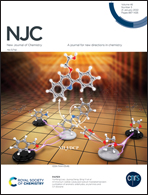Structural and electronic configuration of medium-sized strontium doped magnesium SrmMgn clusters and their anions†
Abstract
Bimetallic clusters have received extensive attention due to the changes in their properties and structures. Therefore, the structure and electronic configuration of medium-size Sr-doped magnesium clusters were studied in this work. The CALYPSO (crystal structure analysis by particle swarm optimization) algorithm and DFT (density functional theory) were applied to search, correct energy, and optimize geometry for stable low-energy structures. We described the structural evolution and characteristics of SrmMgn0/− (m = 1,2; n = 10–15) clusters, and found that a few ground-state isomers can maintain the same structure framework as the corresponding pure magnesium clusters. Through relative stability analysis, the SrMg13− cluster with a pyramid shape and Sr2Mg11 cluster with a pagoda-like shape were determined to be the most stable structures. Further analysis of the molecular orbitals and bonding characteristics of SrMg13− and Sr2Mg11 clusters also revealed a strong interaction between Sr and Mg atoms and the s–p bonding of Mg–Mg, which may be the main reason for the high stability of these clusters. We hope that this study will provide guidance for future doping of pure magnesium clusters.



 Please wait while we load your content...
Please wait while we load your content...